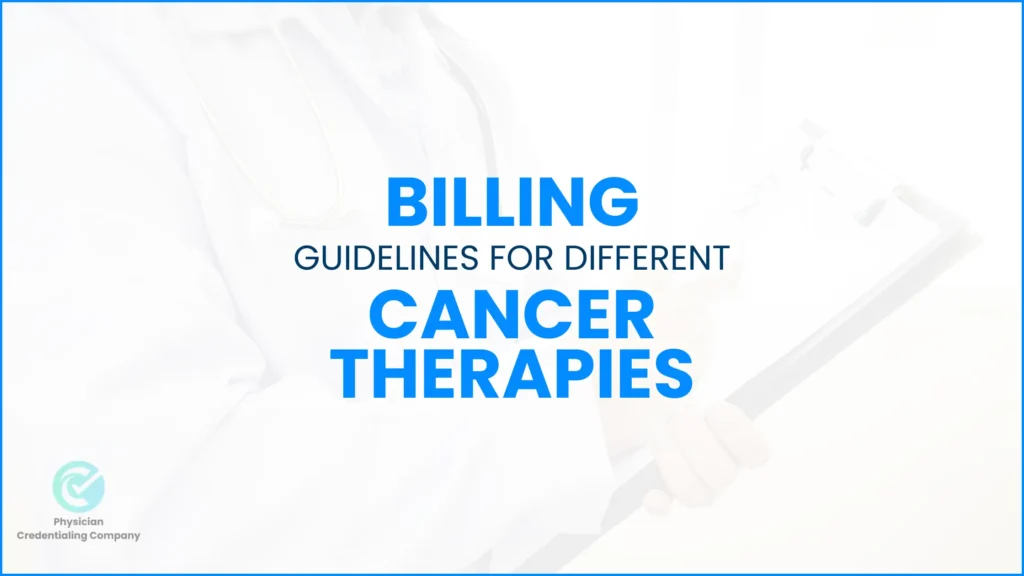Medical oncology billing is an important part of the revenue management cycle. It is used to bill for the medical services provided to the patients. Diagnosis, treatment and follow-ups are billed using the specific billing codes. These codes are used in medical bills to get reimbursement from the insurance companies. It is a complex and intricate process that maintains the financial pattern of any organization. Keeping in view the significance of the medical billing process, healthcare professionals should get a complete understanding of rules and regulations for an accurate and efficient process. If we talk about oncology billing, and medical oncology billing guidelines, they become more complex due to the wide nature of the disease, including different treatment options and low to high-risk medical decision-making (MDM).
In this article, we will learn the basics of oncology medical billing and its necessary billing guidelines. We will also talk about the common challenges healthcare professionals face while billing for oncology services.
Understanding of Oncology Billing Basics
Oncology is actually the study of cancer dealing with its diagnosis, evaluation, investigations and management plan for its treatment. This ailment is life-threatening, and highly skilled providers can deal with such a situation. For combating cancer, medical services, starting from initial consultations and diagnostic lab tests to treatment and survival plans, are billed by oncology CPT codes. Each CPT code defines a specific oncology service provided to the patient. To get reimbursed for the services, there are oncology billing guidelines introduced by the government and payers that need to be followed.
Health Insurance Portability and Accountability Act (HIPAA) and Centers for Medicare and Medicaid Services (CMS) urge the providers to not only bill accurately but also adhere to their compliance rules. For violating rules and regulations, providers have to face severe financial penalties and they may even lose their billing contract.
Step-By-Step Process for Oncology Billing
Considering the complex nature of the oncology billing process, healthcare professionals should seek complete billing knowledge and guidelines. Knowing about each billing step helps to enhance the credibility and transparency of the process. There are a few steps which need to be followed:
1. Prior-Authorization
Due to the expensive nature of treatment plans and lab tests, payers ask for a prior-authorization protocol. Healthcare professionals send reports to the payers mentioning the medical indications justifying the need of desired investigation or treatment. Payers verify the information and give the approval for the mentioned medical service. It verifies that payers will bill for the medical services rendered to the patient. This protocol helps to reduce the denial rate and avoid confusion on medical bills among all concerned parties.
2. Documentation Requirement
Documentation is considered an important protocol for claim submission, internal and external audits and maintaining health records. Documentation is done starting from the patient’s presentation in the healthcare facility, evaluation, diagnosis, treatment, and results of the ailment. Each and every step must be noted in written form to justify the legitimacy of the claims. Lack of documented evidence about the rendered oncology services is considered a breach of policy regulations, and it is dealt with harshly by insurance payers and state regulatory authorities.
3. Claim Submission & Follow-Up
After the completion of documentation and coding, medical bills are submitted to the payers along with other necessary documents. In oncology billing, payers like private insurance companies or Medicare may seek extra documentation and information which needs to be submitted timely. Once a claim is submitted, payers review the claims and make a decision about the reimbursement.
In case of any objection by the payers, providers need to check their whole billing process for potential mistakes, rectify it and resubmit the claim.
Remaining in contact with payers is very essential for effective communication and getting reimbursed for all the submitted claims. It is also necessary to decide the reimbursement rate for each medical service mutually before starting the billing process.
Billing Guidelines for Different Cancer Therapies

1. Billing for Chemotherapy
For chemotherapy billing, oncology CPT codes differ on the administration route, whether it is intravenous, oral or injections. 96413 code is specified for intravenous chemotherapy, and 96417 refers to the sequential intravenous doses. These codes identify the type and order of chemotherapy sessions, and providers must have information and an understanding of how to use these codes accurately to bill for chemotherapy.
Modifier 25 can also be used if other medical services are provided to the patient in addition to chemotherapy during the same visit; Modifier use avoids confusion and clearly helps to state the exact services provided to the patients in the medical bill.
2. Billing for Radiation Therapy
Radiation therapy is much more expensive than other oncology therapies as advanced and costly equipment, along with highly skilled healthcare professionals, are used on the patient’s side. Reimbursement rates for radiation therapy codes automatically become high. Therefore, each payer has specific guidelines for billing radiation therapy codes. Medicare demands detailed written reports about its medical necessity and process details before releasing funds for reimbursement.
CPT codes for radiation therapy refers to the medical evaluation of patients and devising management plans accordingly. CPT code 77401 bills for superficial radiation therapy treatment while 77263 for complex treatment planning.
3. Billing for Immunotherapy
It seems that immunotherapy has administration protocols and processes similar to chemotherapy. But it is not totally true as there are different mechanisms involved in both treatment options. Immunotherapy is the administration of agents which activate the immune system to combat cancer cells. There are different CPT codes, like 96401, used for immunotherapy provided through intravenous injections. While 96402 bills for therapy done using subcutaneous or intramuscular injections.
Common Oncology Billing Challenges
Oncology generally requires the expertise of many healthcare professionals, including medical oncologists, surgical oncologists, radiation oncologists and other allied healthcare professionals, to devise a management plan for cancer patients. All the risk factors and prognosis are considered while treating cancer in this multidisciplinary care. More medical professionals means more complex and difficult billing. Healthcare professionals often bill inaccurate codes for oncology services, leading to financial instability. Undercoding and upcoding are also very important challenges which can be avoided by using professional medical billers and coders.
High denial rates can be a hindrance in your way if you want to grow financially. Denials lead to financial instability and a fall in healthcare standards as well. This is like a vicious cycle as low revenue generation leads to low health standards, which further leads to a loss of trust between providers and payers. Inaccurate documentation is the leading cause of claim denials, and huge care should be given to maintaining documentation protocols.
Incomplete understanding or incorrect use of CPT and ICD codes is also very concerning for healthcare professionals. Basic requirements for successful claim rejection require the correct use of codes elaborating on the actual medical services rendered to the patients. ICD codes represent the medical necessity and patient condition regarding the cancer ailment, while CPT codes elaborate the oncology services. Both codes should be used accurately and justify each other to comply with billing rules.
Best Oncology Billing Practices

Use Technology & Experts
To streamline the billing process, there are many billing software in the market which can automate the billing process. Additionally, you can link billing software to electronic health records for better data processing. This software automatically undergoes each process, detects errors, rectifies them, and submits perfect claims to payers. If you still face any challenges in the billing process, you need to hire a third party. They have team experts in billing, helping to enhance revenue generation.
Verify Insurance Coverage
What if insurance does not cover the treatment you are planning to provide to the patient? Contact the insurance company or use an online verification process to check the patient’s insurance coverage. Check all the patient’s benefits, deductibles, and copays to ensure that no surprise bill reports are received from the payer. Patients should also be informed of any out-of-pocket medical services. These initial steps help all parties to avoid confusion and frustration while billing for oncology services.
Stay Updated with Payer Policies
In addition to above challenges, periodic changes in the payer policy also puts strain on the medical billers and their efficiency. Medical billers must stay updated with new rules and regulations introduced by the payers and comply with them for successful oncology billing.
There is a strong need to match the evolving pace of the healthcare industry. Failure to comply with new policies and regulations can lead to claim denial and revenue loss. Hire professional medical billers who remain updated with all billing regulations. Medical billers should attend training programs and seminars to understand the new trends and use of technology. Billing teams also need to meet the requirement criteria defined by Medicare’s National Coverage Determination (NCD) and Local Coverage Determination (LCD) policies for billing oncology codes.
Conclusion
Oncology billing is very complex due to the use of codes defining multidisciplinary care, complex treatment plans, intricate medical decision making and services of skilled professionals. However, following medical oncology billing guidelines can help providers bill for all services accurately and get reimbursed. There are a few billing guidelines described by HIPAA and CMS which are standard for all healthcare professionals, and they need to follow them to remain legitimate. Different CPT codes are specified for chemotherapy, radiation therapy and immunotherapy to provide a clear understanding of the nature and type of treatment provided. CPT codes define the routes of administration and severity of disease.
Inaccurate documentation, human errors, high denial rate and wrong use of CPT and ICD codes are the potential challenges healthcare professionals face during billing. These challenges can be overcome by using billing software and electronic health records and hiring billing experts for this process. Training programs and seminars for medical billers also help to enhance skills and understand the new policies and rules. They need to pay attention towards the billing guidelines proposed in this guide to reach sky-high limits.
FAQ - People Also Asks
Yes, it is true that the use of high-cost drugs has special billing guidelines by the medical payers. Payers often ask for prior authorization, detailed documentation and separate bills for such types of services.
Healthcare professionals can reduce claim denials by following all billing protocols defined by payers and state policies. Complete documentation, correct use of CPT codes and modifiers and verifying insurance coverage can lead to less denial rate.
From the Covid pandemic, telemedicine has also started billing oncology services but payers have different guidelines for it. Healthcare professionals need to register their telehealth service with state and payer authorities to get reimbursed for services. They also need to use a modifier defining that oncology services like consultation are given electronically.

